Paper Menu >>
Journal Menu >>
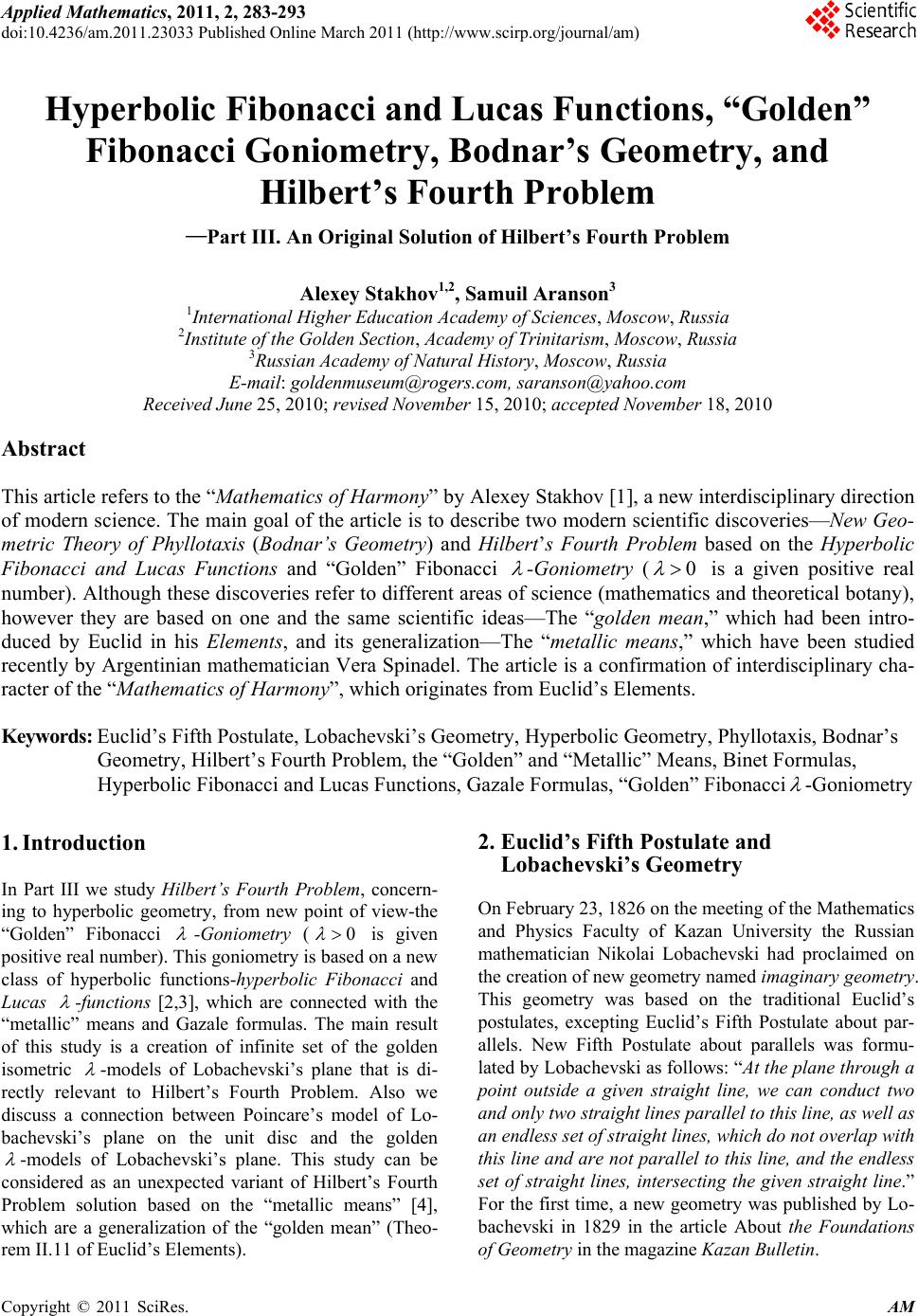 Applied Mathematics, 2011, 2, 283-293 doi:10.4236/am.2011.23033 Published Online March 2011 (http://www.scirp.org/journal/am) Copyright © 2011 SciRes. AM Hyperbolic Fibonacci and Lucas Functions, “Golden” Fibonacci Goniometry, Bodnar’s Geometry, an d Hilbert’s Fourth Problem —Part III. An Original Solution of Hilbert’s Fourth Problem Alexey Stakhov1,2, Samuil Aranson3 1International Higher Education Academy of Sciences, Moscow, Russia 2Institute of the Golden Section, Academy of Trinitarism, Moscow, Russia 3Russian Academy of Natural History, Moscow, Russia E-mail: goldenmuseum@rogers.com, saranson@yahoo.com Received June 25, 201 0; revised November 15, 2010; accepted November 18, 2010 Abstract This article refers to the “Mathematics of Harmony” by Alexey Stakhov [1], a new interdisciplinary direction of modern science. The main goal of the article is to describe two modern scientific discoveries—New Geo- metric Theory of Phyllotaxis (Bodnar’s Geometry) and Hilbert’s Fourth Problem based on the Hyperbolic Fibonacci and Lucas Functions and “Golden” Fibonacci -Goniometry ( is a given positive real number). Although these discoveries refer to different areas of science (mathematics and theoretical botany), however they are based on one and the same scientific ideas—The “golden mean,” which had been intro- duced by Euclid in his Elements, and its generalization—The “metallic means,” which have been studied recently by Argentinian mathematician Vera Spinadel. The article is a confirmation of interdisciplinary cha- racter of the “Mathematics of Harmony”, which originates from Euclid’s Elements. Keywords: Euclid’s Fifth Postulate, Lobachevski’s Geometry, Hyperbolic Geometry, Phyllotaxis, Bodnar’s Geometry, Hilbert’s Fourth Problem, the “Golden” and “Metallic” Means, Binet Formulas, Hyperbolic Fibonacci and Lucas Functions, Gazale Formulas, “Golden” Fibonacci -Goniometry 1. Introduction In Part III we study Hilbert’s Fourth Problem, concern- ing to hyperbolic geometry, from new point of view-the “Golden” Fibonacci -Goniometry ( is given positive real number). This goniometry is based on a new class of hyperbolic functions-hyperbolic Fibonacci and Lucas -functions [2,3], which are connected with the “metallic” means and Gazale formulas. The main result of this study is a creation of infinite set of the golden isometric -models of Lobachevski’s plane that is di- rectly relevant to Hilbert’s Fourth Problem. Also we discuss a connection between Poincare’s model of Lo- bachevski’s plane on the unit disc and the golden -models of Lobachevski’s plane. This study can be considered as an unexpected variant of Hilbert’s Fourth Problem solution based on the “metallic means” [4], which are a generalization of the “golden mean” (Theo- rem II.11 of Euclid’s Elements). 2. Euclid’s Fifth Postulate and Lobachevski’s Geometry On February 23, 1826 on the meeting of the Mathematics and Physics Faculty of Kazan University the Russian mathematician Nikolai Lobachevski had proclaimed on the creation of new geometry named imaginary geometry. This geometry was based on the traditional Euclid’s postulates, excepting Euclid’s Fifth Postulate about par- allels. New Fifth Postulate about parallels was formu- lated by Lobachevski as follows: “At the plane through a point outside a given straight line, we can conduct two and only two straight lines parallel to this line, as well as an endless set of straight lines, which do not overlap with this line and are not parallel to this line, and the endless set of straight lines, intersecting the given straight line.” For the first time, a new geometry was published by Lo- bachevski in 1829 in the article About the Foundations of Geometry in the magazine Kazan Bulletin. 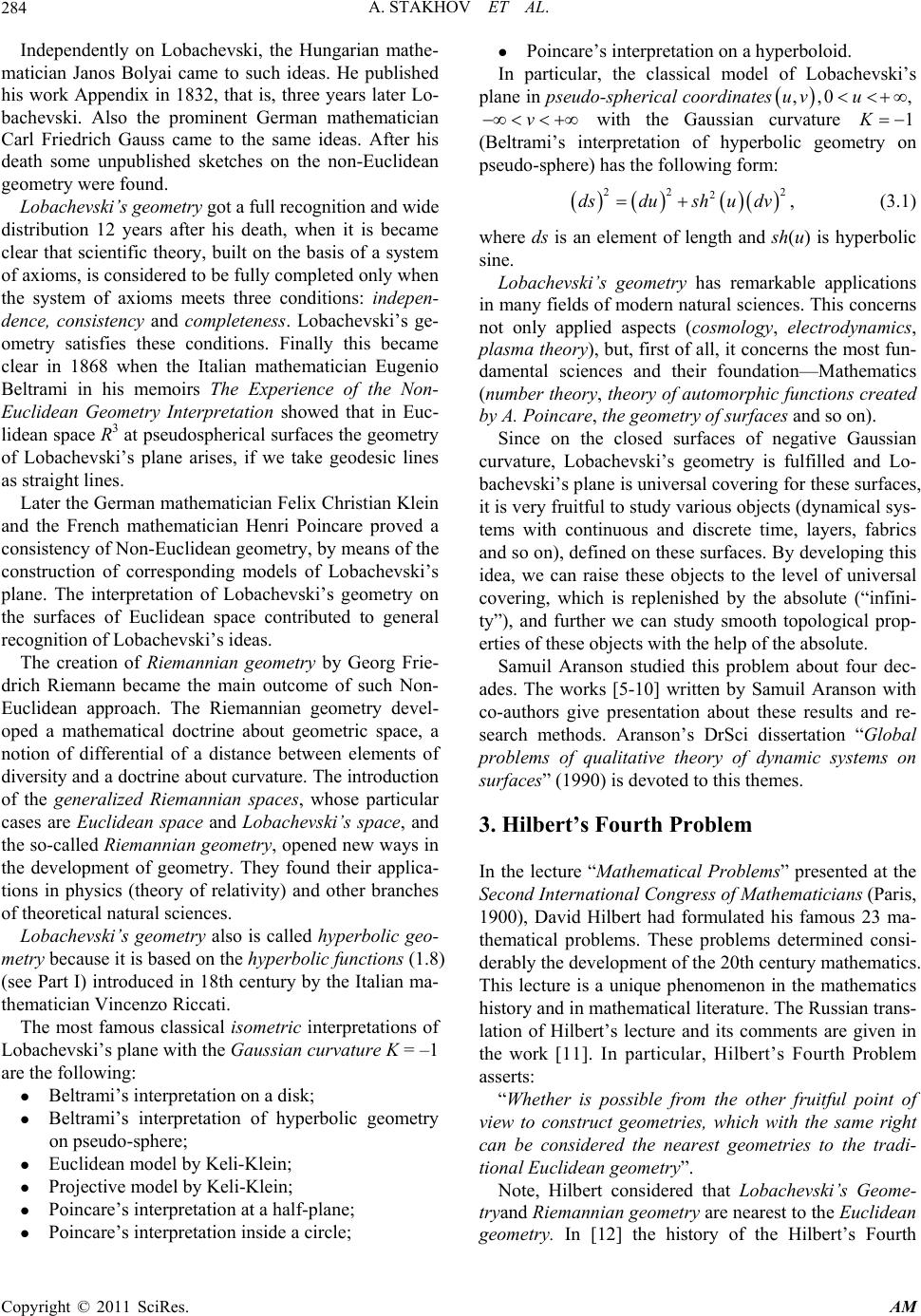 A. STAKHOV ET AL. Copyright © 2011 SciRes. AM 284 Independently on Lobachevski, the Hungarian mathe- matician Janos Bolyai came to such ideas. He published his work Appendix in 1832, that is, three years later Lo- bachevski. Also the prominent German mathematician Carl Friedrich Gauss came to the same ideas. After his death some unpublished sketches on the non-Euclidean geometry were found. Lobachevski’s geometry got a full recognition and wide distribution 12 years after his death, when it is became clear that scientific theory, built on the basis of a system of axioms, is considered to be fully co mpleted only when the system of axioms meets three conditions: indepen- dence, consistency and completeness. Lobachevski’s ge- ometry satisfies these conditions. Finally this became clear in 1868 when the Italian mathematician Eugenio Beltrami in his memoirs The Experience of the Non- Euclidean Geometry Interpretation showed that in Euc- lidean space R3 at pseudospherical surfaces the geometry of Lobachevski’s plane arises, if we take geodesic lines as straight lines. Later the German mathematician Felix Christian Klein and the French mathematician Henri Poincare proved a consistency of Non-Euclidean geometry, by means of the construction of corresponding models of Lobachevski’s plane. The interpretation of Lobachevski’s geometry on the surfaces of Euclidean space contributed to general recognition of Lobachevski’s ideas. The creation of Riemannian geometry by Georg Frie- drich Riemann became the main outcome of such Non- Euclidean approach. The Riemannian geometry devel- oped a mathematical doctrine about geometric space, a notion of differential of a distance between elements of diversity and a doctrine about curvature. The introduction of the generalized Riemannian spaces, whose particular cases are Euclidean space and Lobachevski’s space, and the so-called Riemannian geometry, opened new ways in the development of geometry. They found their applica- tions in physics (theory of relativity) and other branches of theoretical natural sciences. Lobachevski’s geometry also is called hyperbolic geo- metry because it is based on the hyperbolic functions (1.8) (see Part I) introduced in 18th century by the Italian ma- thematician Vincenzo Riccati. The most famous classical isometric interpretations of Lobachevski’s plane with the Gaussian curvature K = –1 are the following: Beltrami’s interpretation on a disk; Beltrami’s interpretation of hyperbolic geometry on pseudo-sphere; Euclidean model by Keli-Klein; Projective model by Keli-Klein; Poincare’s interpretation at a half-plane; Poincare’s interpretation inside a circle; Poincare’s interpretation on a hyperboloid. In particular, the classical model of Lobachevski’s plane in pseudo-spherical coordinates ,,0 ,uv u v with the Gaussian curvature 1K (Beltrami’s interpretation of hyperbolic geometry on pseudo-sphere) has the following form: 22 2 2 dsdush u dv , (3.1) where ds is an element of length and sh(u) is hyperbolic sine. Lobachevski’s geometry has remarkable applications in many fields of modern natural sciences. This concerns not only applied aspects (cosmology, electrodynamics, plasma theory), but, first of all, it concerns the most fun- damental sciences and their foundation—Mathematics (number theory, theory of automorphic functions created by A. Poincare, the geometry of surfaces and so on). Since on the closed surfaces of negative Gaussian curvature, Lobachevski’s geometry is fulfilled and Lo- bachevski’s plane is universal covering for these surfaces, it is very fruitful to study v arious objects (dynamical sys- tems with continuous and discrete time, layers, fabrics and so on), defined on these surfaces. By developing this idea, we can raise these objects to the level of universal covering, which is replenished by the absolute (“infini- ty”), and further we can study smooth topological prop- erties of these objects with the help of the absolute. Samuil Aranson studied this problem about four dec- ades. The works [5-10] written by Samuil Aranson with co-authors give presentation about these results and re- search methods. Aranson’s DrSci dissertation “Global problems of qualitative theory of dynamic systems on surfaces” (1990) is devoted to this themes. 3. Hilbert’s Fourth P ro b l em In the lecture “Mathematical Problems” presented at the Second International Congress of Mathematicians (Paris, 1900), David Hilbert had formulated his famous 23 ma- thematical problems. These problems determined consi- derably the development of the 20th century mathematics. This lecture is a unique phenomenon in the mathematics history and in mathematical l iterature. Th e Russian trans- lation of Hilbert’s lecture and its comments are given in the work [11]. In particular, Hilbert’s Fourth Problem asserts: “Whether is possible from the other fruitful point of view to construct geometries, which with the same right can be considered the nearest geometries to the tradi- tional Euclidean geometry”. Note, Hilbert considered that Lobachevski’s Geome- tryand Riemannian geometry are nearest to the Euclidean geometry. In [12] the history of the Hilbert’s Fourth  A. STAKHOV ET AL. Copyright © 2011 SciRes. AM 285 Problem solution and some approaches to its solution are described. Also Hilbert’s understanding of the Fourth Problem is discussed. It is clear that in mathematics, Hil- bert’s Fourth Problem was a fundamental problem in ge- ometry. In the citation, taken from Hilbert’s original, we found the following description of Hilbert’ Fourth Pro- blem: “the problem is to find geometries whose axioms are closest to those of Euclidean geometry if the ordering and incidence axioms are retained, the congruence axi- oms is weakened, and the equivalent of the parallel postulate is omitted.” In mathematical literature Hilbert’s Fourth Problem is sometimes considered as formulated very vague what makes difficult its final solution [12]. In [13] American geometer Herbert Busemann analyzed the whole range of issues related to Hilbert’s Fourth Problem and also con- cluded that the question related to this issue, unnecessa- rily broad. Note also the book [14] by Alexei Pogorelov devoted to partial solution to Hilbert’s Fourth Problem. The book identifies all, up to isomorphism, implementa- tions of the axioms of classical geometries (Euclid, Lo- bachevski and elliptical), if we delete the axiom of con- gruence and refill these systems with the axiom of “tri- angle inequality.” In spite of critical attitude of mathematicians to Hil- bert’s Fourth Problem, we should emphasize great im- portance of this problem for mathematics, particularly for geometry. Without doubts, Hilbert’s intuition led h im to the conclusion that Lobachevski’s geometry and Rie- mannian geometry do not exhaust all possible variants of non-Euclidean geometries. Hilbert’s Fourth Problem di- rects attention of researchers at finding new non-Eucli- dean geometries, which are the nearest geometries to the traditional Euclidean geometry. In this connection, a discovery of new class of hyper- bolic functions based on the “golden mean” and “metal- lic means” [2,3,15] and following from them new geo- metric theory of phyllotaxis (Bodnar’s geometry) [16] have a principal importance for the development of geo- metry because it shows an existence of new non-Eucli- dean geometries in surrounding us world. Recently Ale- xey Stakhov gave a wide generalization of the symmetric hyperbolic Fibonacci and Lucas functions (1.9) and (1.10) (see Part I) and developed the so-called hyperbolic Fi- bonacci and Lucas -functions [3]. It is proved in [3] an existence of infinite variants of new hyperbolic func- tions, which can be a base for new non-Euclidean geo- metries. The main purpose of Part III of the article is to devel- op this idea, that is, to create new non-Euclidean geome- tries based on the hyperbolic Fibonacci and Lucas - functions introduced in [3]. This study can be considered as unexpected and original solution of Hilbert’s Fourth Problem based on the the “metallic means” [4]. The au- thors of this article announced this idea in [17]. In Part III of the article we give a detailed proof of this idea. 4. The “Golden” Fibonacci λ-Goniometry and Hilbert’s Fourth Problem 4.1. “Golden” Metric λ-Forms of Lobachevski’s Plane In connection with Hilbert’s Fourth Problem the au- thors of the present article Alexey Stakhov and Samuil Aranson suggested in [17] infinite set of metric forms of Lobachevski’s plane in dependence on real parameter . These metric forms are given in the coordinates ,,0 ,uv uv ; they have the Gaussian curvature K= –1 and can be represented in the form: 22 22 2 24 ln 4 dsdusF udv , (3.2) where 2 4 2 λ is the “metallic mean” and s Fu is hyperbolic Fibonacci -sine. Let us name the forms (3.2) metric -forms of Lobachevski’s plane. In [17] we asserted (without proof) that for any real parameter the metric forms (3.2) are isometric on the base of diffeomorphisms 2 2 4 ,2 4 ,, 2 uuu vArcchcFu A rcshsFuvvu vv (3.3) to the classical metric forms of Lobachevski’s plane (3.1) in semi-geodesic coordinates (u,v),0u, v . Since the forms of the kind (3.1) are isometric to all previously known classical metric forms of Lobach-evs- ki’s plane what is noted, for instance, in [18], th en it fol- lows from here that the forms (3.2) are isometric to all these classical forms. Here we give direct proof of isometrics of the form (3.2) and (3.1). Next we describe the basic geometric objects so, for instance, as geodesic lines and intersection angles, which are induced by the form (3.2). In the concluding part for completeness of presenta- tion it is shown also isometrics between Poincare’s model of Lobachevski’s plane on unit disc and the form (3.2). From here it is easy to deduce for the form (3.2) the formula for distance and also the formula for metrics movement. 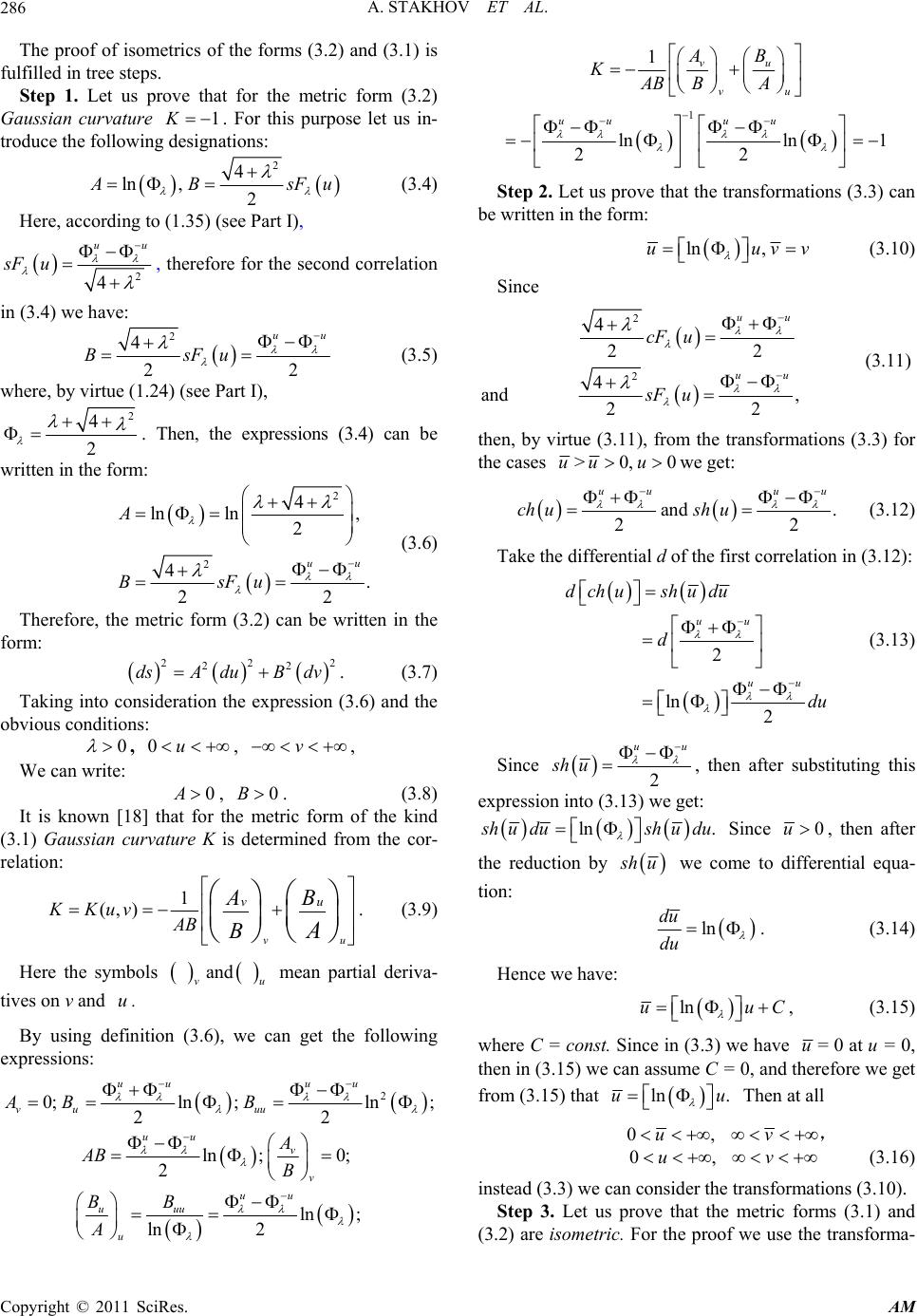 A. STAKHOV ET AL. Copyright © 2011 SciRes. AM 286 The proof of isometrics of the forms (3.2) and (3.1) is fulfilled in tree steps. Step 1. Let us prove that for the metric form (3.2) Gaussian curvature 1K . For this purpose let us in- troduce the following designations: 2 4 ln ,2 A BsFu (3.4) Here, according to (1.3 5) (see Part I), 2 4 uu sF u , therefore for the second correlation in (3.4) we have: 2 4 22 uu BsFu (3.5) where, by virtue (1.24) (see Part I), 2 4 2 . Then, the expressions (3.4) can be written in the form: 2 2 4 ln ln, 2 4. 22 uu A BsFu (3.6) Therefore, the metric form (3.2) can be written in the form: 222 22 dsA duBdv. (3.7) Taking into consideration the expression (3.6) and the obvious conditions: 0 , 0u, v , We can write: 0A, 0B. (3.8) It is known [18] that for the metric form of the kind (3.1) Gaussian curvature K is determined from the cor- relation: 1 (,) vu vu KKuvAB AB BA . (3.9) Here the symbols and vu mean partial deriva- tives on v and u. By using definition (3.6), we can get the following expressions: 2 0;ln ;ln; 22 uu uu vu uu AB B ln ;0; 2 uu v v A AB B ln ; ln 2 uu uuu u BB A 1vu vu AB KAB BA 1 ln ln 22 uu uu 1 Step 2. Let us prove that the transformations (3.3) can be written in the form: ln ,uuvv (3.10) Since 2 2 4 22 4 and , 22 uu uu cF u sF u (3.11) then, by virtue (3.11), from the transformations (3.3) for the cases u>0, 0uuwe get: and . 22 uu uu ch ush u (3.12) Take the differential d of the first correlation in (3.12): 2 ln2 uu uu dchu shudu d du (3.13) Since 2 uu sh u , then after substituting this expression into (3.13) we get: ln . s hu dushu du Since 0u, then after the reduction by s hu we come to differential equa- tion: ln du du . (3.14) Hence we have: lnuuC , (3.15) where C = const. Since in (3.3) we have u= 0 at u = 0, then in (3.15) we can assume C = 0, and therefore we get from (3.15) that ln .uu Then at all 0,u v, 0,u v (3.16) instead (3.3) we can consider the transformations (3.10). Step 3. Let us prove that the metric forms (3.1) and (3.2) are isometric. For the proof we use the transforma- 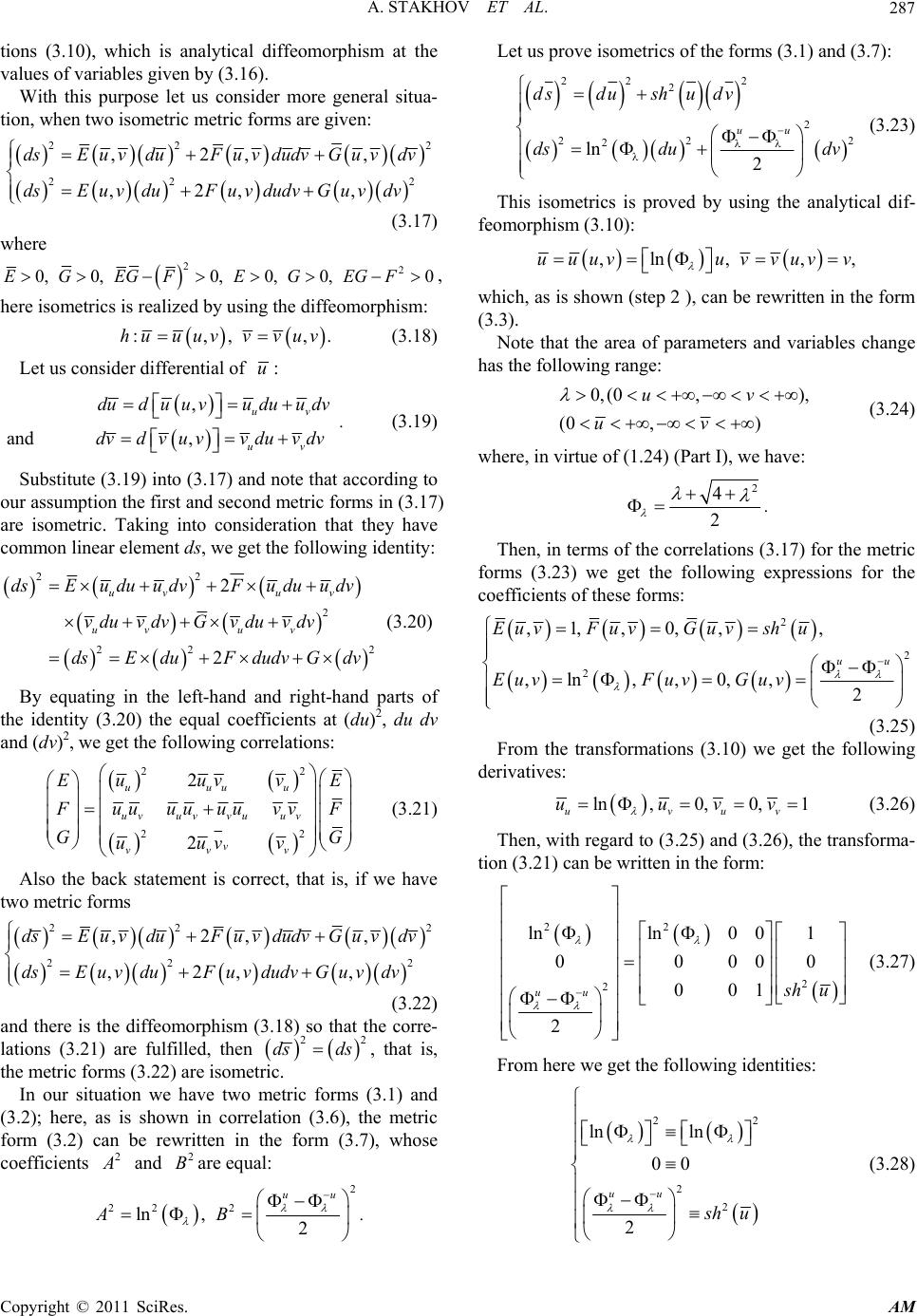 A. STAKHOV ET AL. Copyright © 2011 SciRes. AM 287 tions (3.10), which is analytical diffeomorphism at the values of variables given by (3.16). With this purpose let us consider more general situa- tion, when two isometric metric forms are given: 22 2 22 2 ,2, , ,2, , dsEuvduFuvdudvGuvdv dsEuvduFu vdudvGuvdv (3.17) where 22 0, 0,0, 0, 0,0EGEGF EGEGF , here isometrics is realized by using the diffeomorphism: :,, ,.hu uuvv vuv (3.18) Let us consider differential of u: , and , uv uv duduuvuduu dv dvdvuvvduv dv . (3.19) Substitute (3.19) into (3.17) and note that according to our assumption the first and second metric forms in (3.17) are isometric. Taking into consideration that they have common linear element ds, we get the following identity: 2 2 2 22 2 2 2 uv uv uv uv dsEuduudvFudu udv v duvdvGv duvdv dsEduF dudv Gdv (3.20) By equating in the left-hand and right-hand parts of the identity (3.20) the equal coefficients at (du )2, du dv and (dv)2, we get the following correlations: 22 22 2 2 uuuu uvuv vuuv v vvv Euuv vE F uuuu uuvvF GG uuvv (3.21) Also the back statement is correct, that is, if we have two metric forms 22 2 22 2 ,2, , ,2, , dsEu vduFu vdudvGu vdv dsEuv duFuvdudvGuv dv (3.22) and there is the diffeomorphism (3.18) so that the corre- lations (3.21) are fulfilled, then 22 ds ds, that is, the metric forms (3.22) are isometric. In our situation we have two metric forms (3.1) and (3.2); here, as is shown in correlation (3.6), the metric form (3.2) can be rewritten in the form (3.7), whose coefficients 2 A and 2 Bare equal: 2 22 2 ln ,2 uu AB . Let us prove isometrics of the forms (3.1) and (3.7): 22 2 2 2 22 2 2 ln 2 uu dsdushu dv ds dudv (3.23) This isometrics is proved by using the analytical dif- feomorphism (3.10): ,ln ,,,uuuvuvvuv v which, as is shown (step 2 ), can be rewritten in the form (3.3). Note that the area of parameters and variables change has the following range: 0,(0 ,), (0 ,) uv uv (3.24) where, in virtue of (1.24) (Part I), we have: 2 4 2 . Then, in terms of the correlations (3.17) for the metric forms (3.23) we get the following expressions for the coefficients of these forms: 2 2 2 ,1,,0,, , ,ln ,,0,,2 uu EuvFuvGuvshu EuvFuv Guv (3.25) From the transformations (3.10) we get the following derivatives: ln,0,0, 1 uvuv uuvv (3.26) Then, with regard to (3.25) and (3.26), the transforma- tion (3.21) can be written in the form: 22 2 2 lnln001 00000 001 2 uu s hu (3.27) From here we get the following identities: 22 2 2 ln ln 00 2 uu s hu (3.28)  A. STAKHOV ET AL. Copyright © 2011 SciRes. AM 288 The first two identities from (3.28) are obvious. The last identity from (3.28) follows from the second correla- tion in (3.12), which is proved in step 2 at ln ,uu where>0 and >0λu . Thus, by using the transformations (3.10), we have proved that the metric forms (3.1) and (3.2 ) a re isom etric. Hence, at all 0,(0 ,)uv , the golden metric -forms of Lobachevski’s plane of the kind (3.2) are isometric to all previous known isometric between themselves metric forms of Lobachevski’s plane. 4.2. Partial Cases of the Golden Metric λ-Forms of Lobachevski’s Plane. 1) The golden metric form of Lobachevski’s plane For the case 1 we have115 1.61803 2 — the golden mean, and hence the form (3.2) is reduced to the following: 2 22 2 25 ln 4 dsdusFs udv (3.29) where 22 115 ln ln0.231565 2 and 11 5 uu sFs u is symmetric hyperbolic Fibonacci sine (see Part I). Let us name the metric form (3.29) the golden metric form of Lobachevski’s plane. 2) The silver metric form of Lobachevski’s plane For the case 2 we have 2122.1421 — The silver mean, and hence the form (3.2) is reduced to the following: 2 22 2 22 ln 2dsdusF udv , (3.30) where 22 ln 0.776819 and 22 222 uu sF u . Let us name the metric form (3.30) the silver metric form of Lobachevski’s plane. 3) The bronze metric form of Lobachevski’s plane For the case 3 we have 3313 3.30278 2 —the bronze mean, and hence the form (3.2) is reduced to the following: 2 222 23 13 ln 4 dsdusFudv (3.31) where 23 ln 1.42746 and 33 313 uu sF u . Let us name the metric form (3.31) the bronze metric form of Lobachevski’s plane. 4) The cooper metric form of Lobachevski’s plane For the case 4 we have 425 4.23607 —The cooper mean, and hence the form (3.2) is reduced to the following: 2 22 2 24 ln 5dsdusFudv , (3.32) where 24 ln 2.08408 and 44 4. 25 uu sF u Let us name the metric form (3.32) the cooper metric form of Lobachevski’s plane. 5) The classical metric form of Loba chev sk i’s p lan e in semi-geodesic coordinates. For the case 21 e s h 2.350402 . we have 2.7182 ee -Napier number, and hence the form (3.2) is reduced to the expression (3.1), which gives classical metric form of Lobachevski’s plane in semi-geodesic coordinates ,uv , where 0u , v . 4.3. Geodesic Lines of the Golden Metric λ-Forms of Lobachevski’s Plane and Other Geometric Objects. Geodesic lines and angles between these geodesic lines are one of basic geometric concepts of inner geometry. If metric form is given, then geodesic lines are determined as extremums of functional of curve length. We proved above (see step 3) that the golden metric -forms of Lobachevski’s plane of the kind (3.2) coin- cide with the metric forms of (3.7). For convenience, we introduce new designations for these forms: 2 22 2 2 dsAduBudv , (3.33) where 2 ln 0,0, 2 4,0,0 , 2 uu ABu uv (3.34) It is easy to prove (see also the formula (3.12)), that for the conditions (3.34) we have: 0, 2 0 2 uu uu shAuBu chAuC u (3.35) Let us consider three-dimensional Minkowski’s space 3,,LXYZ with Minkowski’s metrics  A. STAKHOV ET AL. Copyright © 2011 SciRes. AM 289 2222 dldXdY dZ, (3.36) where dl is linear element of the space 3 L. Now let us consider the upper half 2 M of the two-sheet hype rboloid: 22 2 1, 0XYZ X . (3.37) The surface 2 M is given in implicit form. We can give the surface 2 M , if we fulfill the following special parameterization: , ,coscos ,sinsin XXuv chAu Cu YYuvshAu vBu v Z Zuv shAuv Buv (3.38) By direct testing, we can verify that 222 ,,,1,,0.XuvY uvZ uvX uv (3.39) Let us substitute (3.38) into the correlation (3.36); then on the upper half 2 M of two-sheet hyperboloid we get the metric form: 2 22 2 2 dlAduBudv , (3.40) where A and B(u) has a form (3.34). From here we get the golden metric -form of Lobachevski’s plane of the kind (3.3 3): 2 22 22 2 dsdlAduBudv Let us consider in the space 3,,LXYZ the fol- lowing planes 222 0, 0aX bY cZabc , (3.41) which pass through the coordinate origin 0,0,0O and intersect the upper half of the two-sheet hyperboloid (3.37), if the coefficients of the equation (3.41) satisfy to the following restriction: 222 0abc. (3.42) Then the intersection lines of the planes (3.41) with the surface (3.37) are geodesic lines on the surface (3.37) in the metrics (3.36) (see [17]). This is analogous to the case, when at the unit sphere 222 2 :1SX YZ the intersection lines of the planes 0aXbY cZ (where 222 0abc ) with this sphere are geodesic lines in the metrics of constant Gaussian curvature 1 K . If we substitute (3.38) into (3.41), then in the golden -metrics (3.33) in the coordinates ,uv we get the following equation of geodesic lines in the following implicit form: cossin 0,ach Aubsh Auvcsh Auv (3.43) where 0,(0 ,)uv , 2 4 ln 0,1 2 A . Note that coefficients a, b, c in (3.43) satisfy to the re- strictions: 222 0abc , 222 0abc . (3.44) Let us rewrite (3.43) in the form: ,cossin0. uu uu Fuvabvcv (3.45) Let 00 ,uv be coordinates of the intersection point of two geodesic lines given the equations: 111 1 222 2 ,cossin0 ,cossin0 uu uu uu uu Fuvabv cv Fuvabv cv The angle of intersection of two geodesic lines (counted counter-clockwise), according to the formulas of differential geometry, can be found from the correla- tion: 21212 1112 1222 FF FF EG Fdudvdv du tg F FFFFFFF EF G du dvdudvdvdududv (3.46) where the right-hand parts in (3.46) are taken in the point 00 ,uv and ,EEuv, , F Fuv, ,GGuv are coefficients of the metric form 22 2 2dsE dvFdudvGdv. Note that the formulas for sin and cos are written by analogy. In our situation, acco rd ing to (3.2 ), (3. 4), (3 .33 ), (3. 34 ), we have: 2 2 222 ln, 0, 4ln 22 uu EF GsFushu . (3.47) Partial derivatives on u and v of the function , F uv of the kind (3.45) have the fo llowing fo rms: 2 ln ,sincos ln FF abvcv uv ch u (3.48)  A. STAKHOV ET AL. Copyright © 2011 SciRes. AM 290 Further by analogy on Lobachevski’s plane, provided by the golden metric -forms (3.2), at any real number 0 we can find corresponding formulas for distances between two points, transformations of movement, and all other mathematical objects, inherent in this remarka- ble geometry. The authors of the present article do not pursue a goal to write out all corresponding formulas and geometric constructions, which are connected with the golden me- tric -forms of Lobachevski’s plane because this prob- lem is a subject of separate study. In this conn ection, it would be very fruitful to unite in further the developed by the authors golden metric -forms of Lobachevski’s plane of the kind (3.2), rea- lized at any real number on the half-plane ,0 ,uvuv and having Gau- ssian curvature 1K , with the well-known studied and convenient for applications classical model of Lo- bachevski’s plane, suggested in 1882 by Great French mathematician, physicist, and astronomer Henry Poin- care on a disc 22 2 :1Dx y , (3.49) completed by the absolute 22 :1Ex y, which plays a role of a carrier of the infinitely distant points of Loba- chevski’s plane. 4.4. Poincare’s Model of Lobachevski’s Plane on the Unit Disc Let us remind the basic facts of Lobachevski’s geometry for Poincare’s realization on a disc (3.49). Information is taken from [18]. Poincare’s metric form of Gaussian curvature 1 K h as th e following form: 22 2 2 22 4 1 dx dy ds xy . (3.50) Geodesic planes for Poincare’s model are or circle arcs, which are orthogonal to absolute (if these geodesic lines do not contain the coordinate origin 0.0O) or segments of right lines (if these geodesic lines pass through the coordinate origin). In general case the geodesic lines equation in Poin- care’s model has the following form: 22 22 ,1220, 1,Fxy axybxcyx y (3.51) where 222 222 0, 0.abc abc The angle of intersection of two geodesic lines, which is counted counter-clockwise, is determined from the correlations: 12 12 112 2 F FFF x yyx tg F FFF x yxy (3.52) where the right-hand parts in (3.52) is taken in the point 00 , x y being a common point of the geodesic lines intersection: 22 11 11 22 22 22 ,1 220 ,1 220 Fxyaxybx cy Fxyaxybx cy (3.53) Thus, in the metrics (3.50) the angles are measured in Euclidean sense. Let 1112 22 ,and , A xyAxy be arbitrary points of Lobachevski’s plane, which is realized in the form of a circle (3.49) with the metrics (3.50). We use complex numbers further. We designate the point , A xy by zxiy , where 1i is im- aginary unit. A module of the complex number z is equal to 2 2 z y x . Let zxiy be a complex number conjugate to the complex number zxiy. For this case the points 111222 ,and, A xyAx yin complex notation can be represented as follows: 1112 22 ,zxiy zxiy . It is well-known that a dis- tance 12 , A A between two points 111 , A xy and 222 , A xy in complex notation has the following form: 12 2 1 12 12 2 1 1 ,ln 1 zz zz AA zz zz (3.54) In complex notation the metrics (3 .50) has the follow- ing form : 2 2 2 4,1. 1 dsdzdz z z (3.55) The movement of the metrics (3.55) of Lobachevski’s plane is written as follows: 22 ,1, Az B zfzA B Bz A (3.56) where andzxiyz xiy . Note that at the move- ments (3.56) the distances between points and angles between geodesic lines are kept. 4.5. Connection Between Poincare’s Model of Lobachevski’s Plane in the Unit Disc and the Golden λ-Models of Lobachevski’s Plane It is proved in [18] that the upper half 2 M of the two- 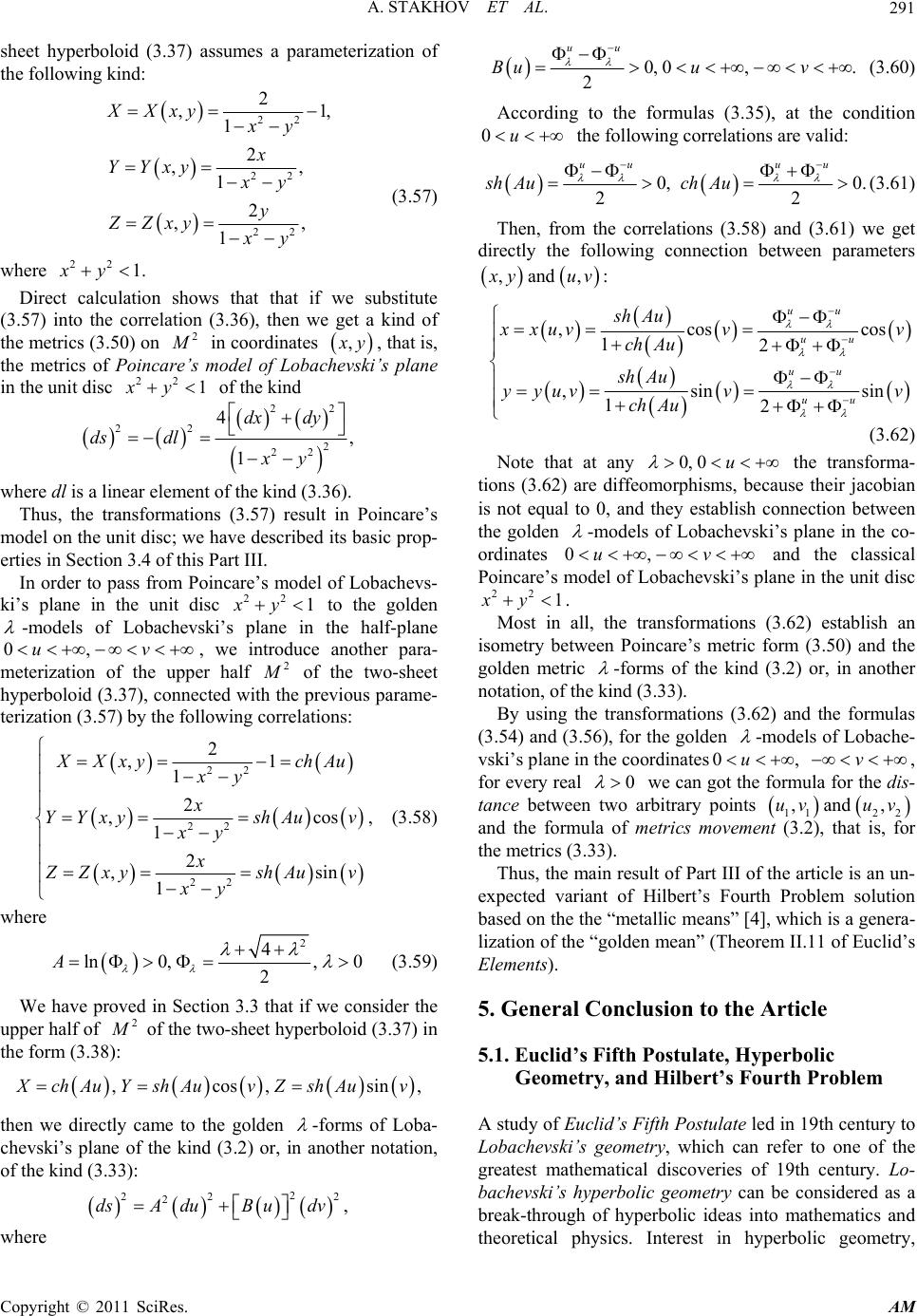 A. STAKHOV ET AL. Copyright © 2011 SciRes. AM 291 sheet hyperboloid (3.37) assumes a parameterization of the following kind: 22 2 ,1, 1 XXxy xy 22 22 2 ,, 1 2 ,, 1 x YYxy xy y ZZxy x y (3.57) where 22 1.xy Direct calculation shows that that if we substitute (3.57) into the correlation (3.36), then we get a kind of the metrics (3.50) on 2 M in coordinates , x y, that is, the metrics of Poincare’s model of Lobachevski’s plane in the unit disc 22 1xy of the kind 22 22 2 22 4, 1 dx dy ds dl xy where dl is a linear element of the kind (3.36). Thus, the transformations (3.57) result in Poincare’s model on the unit disc; we have described its basic prop- erties in Section 3.4 of this Part III. In order to pass from Poincare’s model of Lobachevs- ki’s plane in the unit disc 22 1xy to the golden -models of Lobachevski’s plane in the half-plane 0,uv , we introduce another para- meterization of the upper half 2 M of the two-sheet hyperboloid (3.37), connected with the previous parame- terization (3.57) by the following correlations: 22 22 22 2 ,1 1 2 ,cos 1 2 ,sin 1 X XxychAu xy x YYxyshAu v xy x Z ZxyshAuv xy , (3.58) where 2 4 ln0,, 0 2 A (3.59) We have proved in Section 3.3 that if we consider the upper half of 2 M of the two-sheet hyperboloid (3.37) in the form (3.38): ,cos,sin, X chAu YshAuvZshAuv then we directly came to the golden -forms of Loba- chevski’s plane of the kind (3.2) or, in another notation, of the kind (3.33 ): 2 22 2 2,dsAduBudv where 0, 0,. 2 uu Buu v (3.60) According to the formulas (3.35), at the condition 0u the following correlations are valid: 0, 0. 22 uu uu sh Auch Au (3.61) Then, from the correlations (3.58) and (3.61) we get directly the following connection between parameters ,and,: x yuv ,cos cos 12 ,sin sin 12 uu uu uu uu sh Au x xuv vv ch Au sh Au yyuv vv ch Au (3.62) Note that at any 0, 0u the transforma- tions (3.62) are diffeomorphisms, because their jacobian is not equal to 0, and they establish connection between the golden -models of Lobachevski’s plane in the co- ordinates 0,uv and the classical Poincare’s model of Lobach evski’s plane in the unit disc 22 1xy . Most in all, the transformations (3.62) establish an isometry between Poincare’s metric form (3.50) and the golden metric -forms of the kind (3.2) or, in another notation, of the kind (3.33). By using the transformations (3.62) and the formulas (3.54) and (3.56), for the golden -models of Lobache- vski’s plane in the coordinates0,u v , for every real 0 we can got the formula for the dis- tance between two arbitrary points 112 2 ,and,uvu v and the formula of metrics movement (3.2), that is, for the metrics (3.33). Thus, the main result of Part III of the article is an un- expected variant of Hilbert’s Fourth Problem solution based on the the “metallic mean s” [4], which is a genera- lization of the “golden mean” (Theorem II.11 of Euclid’s Elements). 5. General Conclusion to the Article 5.1. Euclid’s Fifth Postulate, Hyperbolic Geometry, and Hilbert’s Fourth Problem A study of Euclid’s Fifth Postulate led in 19th cen tury to Lobachevski’s geometry, which can refer to one of the greatest mathematical discoveries of 19th century. Lo- bachevski’s hyperbolic geometry can be considered as a break-through of hyperbolic ideas into mathematics and theoretical physics. Interest in hyperbolic geometry, 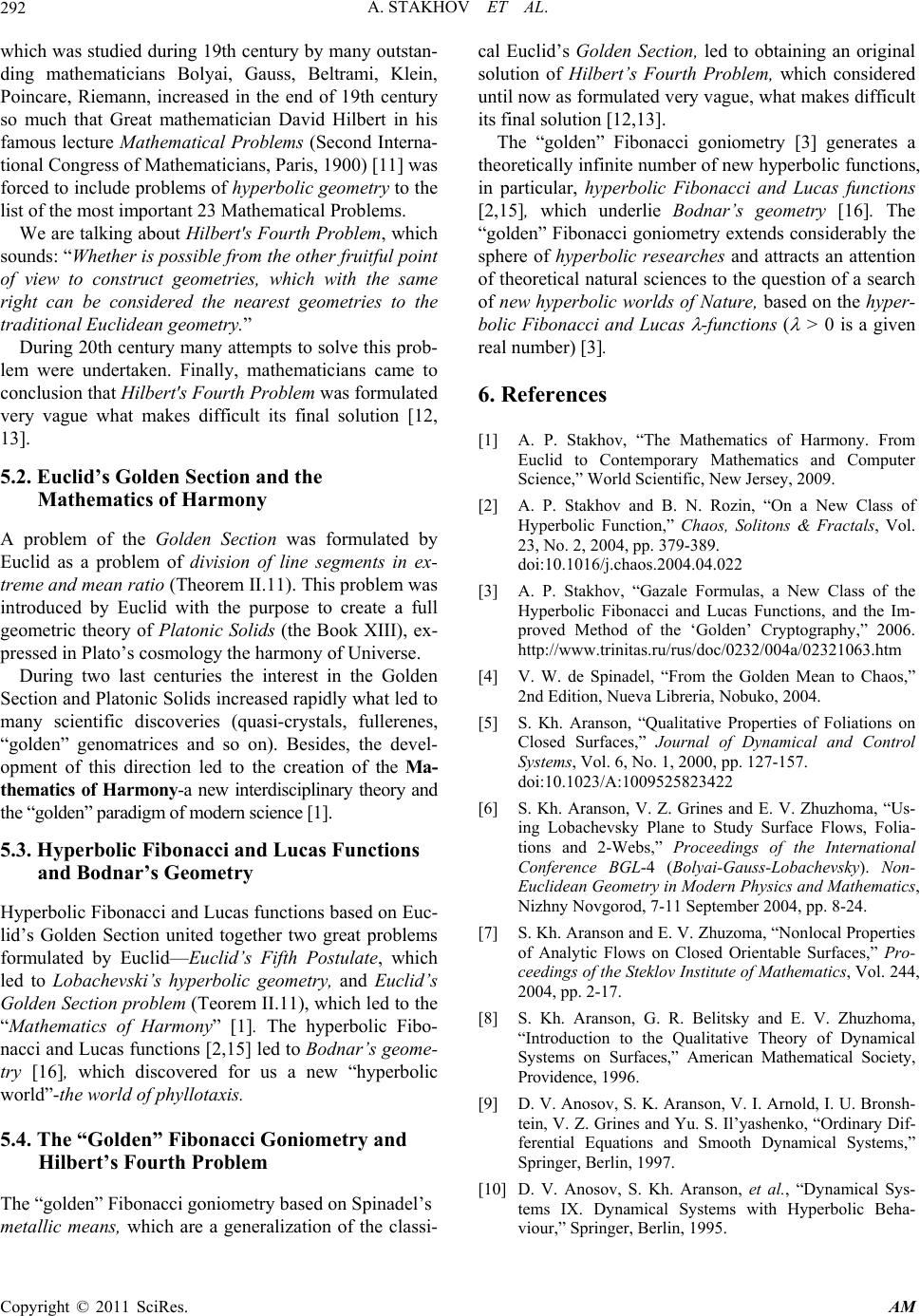 A. STAKHOV ET AL. Copyright © 2011 SciRes. AM 292 which was studied during 19th cen tury by many outstan- ding mathematicians Bolyai, Gauss, Beltrami, Klein, Poincare, Riemann, increased in the end of 19th century so much that Great mathematician David Hilbert in his famous lecture Mathematical Problems (Second Interna- tional Congress of Mathematicians, Paris, 1900) [11] was forced to include problems of hyperbolic geometry to the list of the most important 23 Mathematical Problems. We are talking about Hilbert's Fourth Problem, which sounds: “Whether is possible from the other fruitful point of view to construct geometries, which with the same right can be considered the nearest geometries to the traditional Euclidean geometry.” During 20th century many attempts to solv e this prob- lem were undertaken. Finally, mathematicians came to conclusion that Hilbert's Fourth Problem was formulated very vague what makes difficult its final solution [12, 13]. 5.2. Euclid’s Golden Section and the Mathematics of Harmony A problem of the Golden Section was formulated by Euclid as a problem of division of line segments in ex- treme and mean ratio (Theorem II.11). This problem was introduced by Euclid with the purpose to create a full geometric theory of Platonic Solids (the Book XIII), ex- pressed in Plato’s cosmology the harmony of Universe. During two last centuries the interest in the Golden Section and Platonic Solids increased rapidly what led to many scientific discoveries (quasi-crystals, fullerenes, “golden” genomatrices and so on). Besides, the devel- opment of this direction led to the creation of the Ma- thematics of Harmony-a new interdisciplinary theory and the “gol den” para digm of mo dern sci ence [ 1]. 5.3. Hyperbolic Fibonacci and Lucas Functions and Bodnar’s Geometry Hyperbolic Fibonacci and Lucas functions based on Euc- lid’s Golden Section united together two great problems formulated by Euclid—Euclid’s Fifth Postulate, which led to Lobachevski’s hyperbolic geometry, and Euclid’s Golden Section problem (Teorem II.11), which led to the “Mathematics of Harmony” [1]. The hyperbolic Fibo- nacci and Lucas functions [2,15] led to Bodnar’s geome- try [16], which discovered for us a new “hyperbolic world”-the world of phyllotaxis. 5.4. The “Golden” Fibonacci Goniometry and Hilbert’s Fourth Problem The “golden” Fibonacci goniometry based on Spinadel’s metallic means, which are a generalization of the classi- cal Euclid’s Golden Section, led to obtaining an original solution of Hilbert’s Fourth Problem, which considered until now as formulated very vague, what makes difficult its final solution [12,13]. The “golden” Fibonacci goniometry [3] generates a theoretically infinite number of new hyperbolic functions, in particular, hyperbolic Fibonacci and Lucas functions [2,15], which underlie Bodnar’s geometry [16]. The “golden” Fibonacci goniometry extends considerably the sphere of hyperbolic researches and attracts an attention of theoretical natural sciences to the question of a search of new hyperbolic worlds of Nature, based on the hyper- bolic Fibonacci and Lucas -functions ( > 0 is a given real number) [3]. 6. References [1] A. P. Stakhov, “The Mathematics of Harmony. From Euclid to Contemporary Mathematics and Computer Science,” World Scientific, New Jersey, 2009. [2] A. P. Stakhov and B. N. Rozin, “On a New Class of Hyperbolic Function,” Chaos, Solitons & Fractals, Vol. 23, No. 2, 2004, pp. 379-389. doi:10.1016/j.chaos.2004.04.022 [3] A. P. Stakhov, “Gazale Formulas, a New Class of the Hyperbolic Fibonacci and Lucas Functions, and the Im- proved Method of the ‘Golden’ Cryptography,” 2006. http://www.trinitas.ru/rus/doc/0232/004a/02321063.htm [4] V. W. de Spinadel, “From the Golden Mean to Chaos,” 2nd Edition, Nueva Libreria, Nobuko, 2004. [5] S. Kh. Aranson, “Qualitative Properties of Foliations on Closed Surfaces,” Journal of Dynamical and Control Systems, Vol. 6, No. 1, 2000, pp. 127-157. doi:10.1023/A:1009525823422 [6] S. Kh. Aranson, V. Z. Grines and E. V. Zhuzhoma, “Us- ing Lobachevsky Plane to Study Surface Flows, Folia- tions and 2-Webs,” Proceedings of the International Conference BGL-4 (Bolyai-Gauss-Lobachevsky). Non- Euclidean Geometry in Modern Physics and Mathematics, Nizhny Novgorod, 7-11 September 2004, pp. 8-24. [7] S. Kh. Aranson and E. V. Zhuzoma, “Nonlocal Properties of Analytic Flows on Closed Orientable Surfaces,” Pro- ceedings of the Steklov Institute of Mathematics, Vol. 244, 2004, pp. 2-17. [8] S. Kh. Aranson, G. R. Belitsky and E. V. Zhuzhoma, “Introduction to the Qualitative Theory of Dynamical Systems on Surfaces,” American Mathematical Society, Providence, 1996. [9] D. V. Anosov, S. K. Aranson, V. I. Arnold, I. U. Bronsh- tein, V. Z. Grines and Yu. S. Il’yashenko, “Ordinary Dif- ferential Equations and Smooth Dynamical Systems,” Springer, Berlin, 1997. [10] D. V. Anosov, S. Kh. Aranson, et al., “Dynamical Sys- tems IX. Dynamical Systems with Hyperbolic Beha- viour,” Springer, Berlin, 1995. 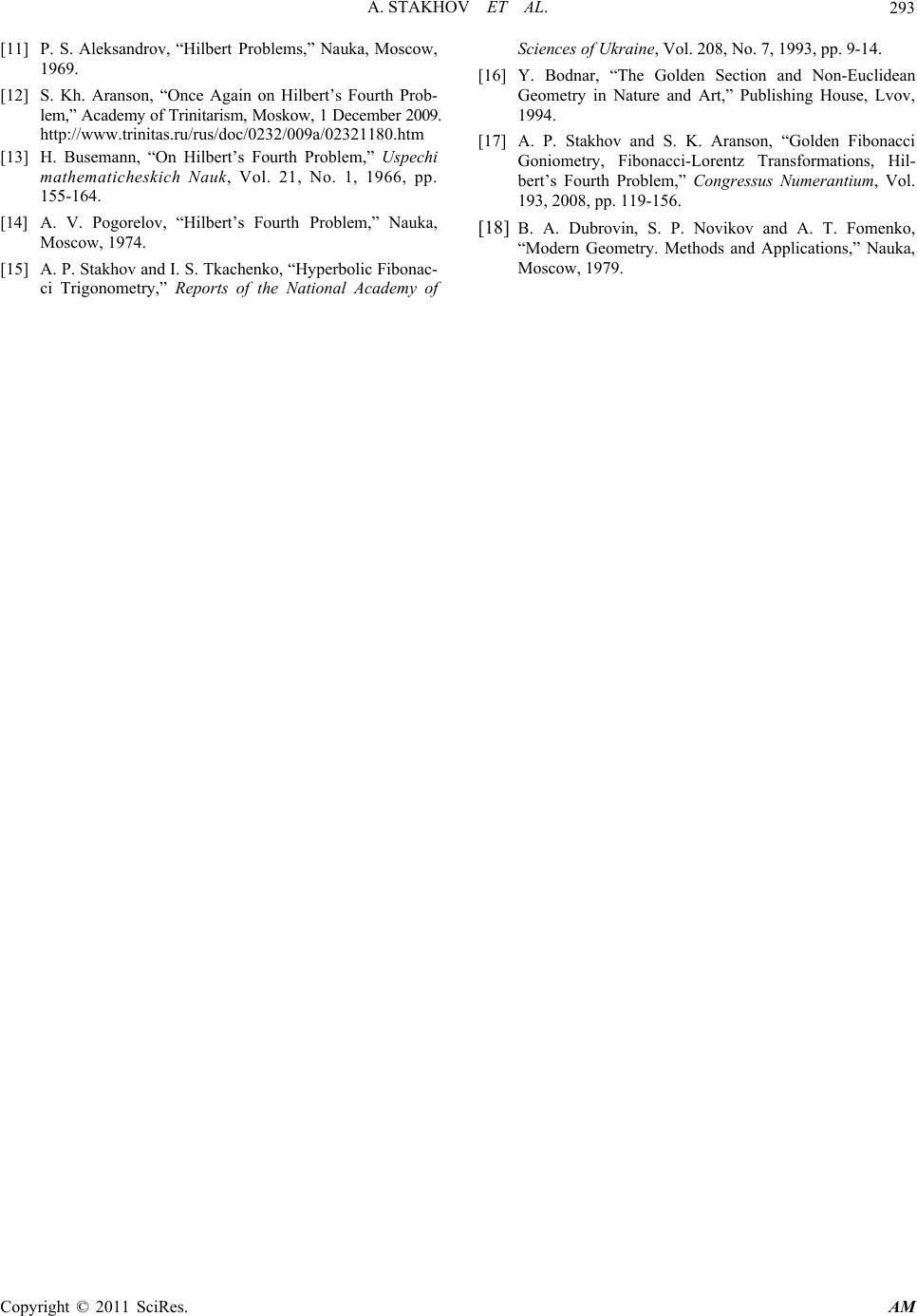 A. STAKHOV ET AL. Copyright © 2011 SciRes. AM 293 [11] P. S. Aleksandrov, “Hilbert Problems,” Nauka, Moscow, 1969. [12] S. Kh. Aranson, “Once Again on Hilbert’s Fourth Prob- lem,” Academy of Trinitarism, Moskow, 1 December 2009. http://www.trinitas.ru/rus/doc/0232/009a/02321180.htm [13] H. Busemann, “On Hilbert’s Fourth Problem,” Uspechi mathematicheskich Nauk, Vol. 21, No. 1, 1966, pp. 155-164. [14] A. V. Pogorelov, “Hilbert’s Fourth Problem,” Nauka, Moscow, 1974. [15] A. P. Stakhov and I. S. Tkachenko, “Hyperbolic Fibonac- ci Trigonometry,” Reports of the National Academy of Sciences of Ukraine, Vol. 208, No. 7, 1993, pp. 9-14. [16] Y. Bodnar, “The Golden Section and Non-Euclidean Geometry in Nature and Art,” Publishing House, Lvov, 1994. [17] A. P. Stakhov and S. K. Aranson, “Golden Fibonacci Goniometry, Fibonacci-Lorentz Transformations, Hil- bert’s Fourth Problem,” Congressus Numerantium, Vol. 193, 2008, pp. 119-156. [18] B. A. Dubrovin, S. P. Novikov and A. T. Fomenko, “Modern Geometry. Methods and Applications,” Nauka, Moscow, 1979. |

